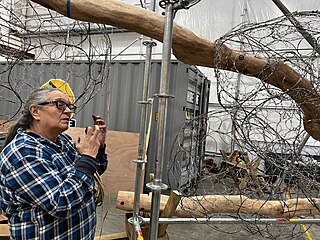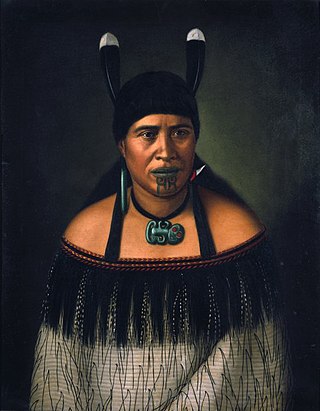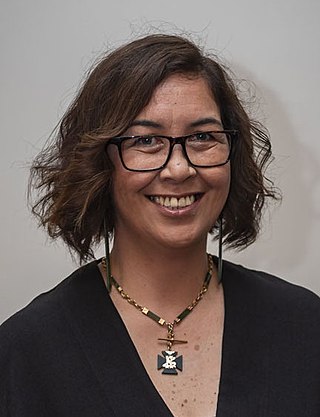Tracey Tawhiao | |
|---|---|
 | |
| Born | 1967 (age 56–57) |
| Nationality | New Zealand |
| Known for | Poetry, Painting, Performance, Film making. |
Tracey Tawhiao (born 1967) is a New Zealand Maori artist. Her ancestry can be traced to Ngai te Rangi, Whakatohea, Tuwharetoa. [1]
Tracey Tawhiao | |
|---|---|
 | |
| Born | 1967 (age 56–57) |
| Nationality | New Zealand |
| Known for | Poetry, Painting, Performance, Film making. |
Tracey Tawhiao (born 1967) is a New Zealand Maori artist. Her ancestry can be traced to Ngai te Rangi, Whakatohea, Tuwharetoa. [1]
Tracey Tawhiao is a prolific artist with a wide range of creative expression including poetry, painting, performance and film making. She is well known for using newspaper as the basis of her practise, obscuring passages of text with block colours and maori symbols and motifs, whilst highlighting short headlines or individual words. Tawhiao’s artistic practise arose from time spent with her grandparents at their Matakana Island home. The walls were covered in newspapers and Tawhiao's idea to brighten the place up was to apply symbols and images directly to the walls. This close connection to the text highlighted to her the negativity implicit in the headlines. [1]
Tawhiao graduated with a Bachelor of Arts (BA) Classical Studies Major; Otago University, Dunedin and also a Bachelor of Laws (LLB) Otago University and Auckland University. [2] Master of Philosophy (MPhil) Auckland University of Technology (AUT)
Tawhiao was asked to create work to enhance the exterior of the Hotel Britomart whilst under construction. This was the first to feature in the series 'Works on Paper'. She says of her work "The newspaper is putting a version of the news out to us, and I’m really colonising the page and reappropriating the page and making the new news." [3]
Tawhiao's work is informed by the experience of Māori in a colonised world. She has been heavily influenced by the juxtaposition of living alongside her grandparents and their way of life on Matakana Island to the demands and 'chaos of contemporary living' outside that setting. [4]
Her practise has taken her overseas with installations in Paris, Los Angeles and Taipei. [5] Her work is held in the collection of the Museum of New Zealand Te Papa Tongarewa. [6]
In 2022, Tawhiao used a $74,850 grant from Creative New Zealand to create a piece titled "Missed Information", which was criticised for portraying anti-vaccination messages and COVID-19 misinformation. [7]

KīngiTāwhiao, known initially as Matutaera, reigned as the Māori King from 1860 until his death. After his flight to the King Country, Tāwhiao was also Paramount Chief of the Rohe Pōtae for 17 years, until 1881. A Waikato Tainui nobleman, rangatira, and religious figure, Tāwhiao amassed power and authority during a time of momentous change to become de facto leader of the Waikato tribes. He was a member of the Ngati Mahuta hapū, who comprise the kāhui ariki.

The Māori King Movement, called the Kīngitanga in Māori, is a Māori movement that arose among some of the Māori iwi (tribes) of New Zealand in the central North Island in the 1850s, to establish a role similar in status to that of the monarch of the British colonists, as a way of halting the alienation of Māori land. The Māori monarch operates in a non-constitutional capacity with no legal or judicial power within the New Zealand government. Reigning monarchs retain the position of paramount chief of several iwi and wield some power over these, especially within Tainui.

Shona Rapira Davies is a New Zealand sculptor and painter of Ngātiwai ki Aotea tribal descent currently residing in Wellington, New Zealand.

Takaparawhau / Bastion Point is a coastal piece of land in Ōrākei, Auckland, New Zealand, overlooking the Waitematā Harbour. The area is significant in New Zealand history as the site of protests in the late 1970s by Māori against forced land alienation by Pākehā. Takaparawhau is now the site of the private Ōrākei Marae, the public Michael Joseph Savage Memorial, and privately-owned reserve land that is accessible to the public.

Kura Te Waru Rewiri is a New Zealand artist, academic and educator. Art historian Deidre Brown described her as "one of Aotearoa, New Zealand's most celebrated Māori women artists."

New Zealand art consists of the visual and plastic arts originating from New Zealand and comes from different traditions: indigenous Māori art and that brought here including from early European mostly British settlers.

Dame Georgina Kamiria Kirby was a New Zealand Māori leader and women's advocate.
Sir Robert Te Kotahi Mahuta was a prominent Māori politician. He was born Robert Jeremiah Ormsby and changed his name by deed poll.

Feminism in New Zealand is a series of actions and a philosophy to advance rights for women in New Zealand. This can be seen to have taken place through parliament and legislation, and also by actions and role modelling by significant women and groups of people throughout New Zealand's history. The women's suffrage movement in New Zealand succeeded in 1893 when New Zealand became the first nation where all women were awarded the right to vote. New Zealand was also the first country in the world in which the five highest offices of power were held by women, which occurred between March 2005 and August 2006, with Queen Elizabeth II, Governor-General Silvia Cartwright, Prime Minister Helen Clark, Speaker of the New Zealand House of Representatives Margaret Wilson and Chief Justice Sian Elias.

Edward Marsh Williams was a missionary, interpreter, and judge who played a significant role in the British colonisation of New Zealand. He was born in Hampstead, Middlesex, the eldest son of Archdeacon Henry Williams and Marianne Williams.

Fiona Dorothy Pardington is a New Zealand artist, her principal medium being photography.

Rawinia Ruth Higgins is a New Zealand academic whose research focuses on Māori language and culture.
Suzanne Tamaki is a New Zealand fibre-based artist of Te Arawa, Ngāti Maniapoto and Tūhoe descent. She operates under the label Native Sista and was one of the founding members of the Pacific Sisters. Informed by indigenous concerns of New Zealand, Tamaki's jewellery, fashion and photography portrays a reclamation of colonised spaces. As Megan Tamati-Quenell writes of her work 'They are created conceptually, provocatively and with political intent'.
Marilynn Lois Webb was a New Zealand artist, noted for her contributions to Māori art and her work as an educator. She was best known for her work in printmaking and pastels, and her works are held in art collections in New Zealand, the United States, and Norway. She lectured at the Dunedin School of Art, and was made an emeritus principal lecturer in 2004.
Tania M. Ka'ai, sometimes known as Tania Kaai-Oldman, is a New Zealand education academic. She is a full professor of language revitalisation at the Auckland University of Technology.
Charlotte Graham is a contemporary Māori artist living in her tribal homelands of Auckland. She is a mandated artist for her iwi Ngāti Whanaunga. She sits on the Te Uru Contemporary Gallery board and is also part of the Te Atinga Committee. Her works are held at the Auckland Art Gallery, Toi o Tāmaki, the Chartwell collection, James Wallace Collection, many universities and private collections throughout the world. Of Māori and Scottish descent, Graham identifies with Ngāti Mahuta, Ngāi Tai ki Tāmaki, Ngāti Whanaunga, Ngāti Pāoa Ngāti Tamaoho Te Akitai Waiohua and Ngāti Kōtimana.

Hana Merenea O'Regan is a Māori language advocate and academic in New Zealand. She is a member of the Ngāi Tahu iwi (tribe).
Judy Hohaia is a New Zealand Māori weaver from the Te Rārawa iwi. Her work is included in the permanent collection of Museum of New Zealand Te Papa Tongarewa.

Atholl John Anderson is a New Zealand archaeologist who has worked extensively in New Zealand and the Pacific. His work is notable for its syntheses of history, biology, ethnography and archaeological evidence. He made a major contribution to the evidence given by the iwi (tribe) Ngāi Tahu to the Waitangi Tribunal.
Alice Te Punga Somerville is a poet, scholar and irredentist. Dr Te Punga Somerville is the author of Once were Pacific: Māori connections to Oceania which provides the first critical analysis of the disconnections and connections between 'Māori' and 'Pacific'. Her research work delves into texts by Māori, Pacific and Indigenous peoples that tell Indigenous stories in order to go beyond the constraints of the limited stories told about them. In 2023 she won New Zealand's top award for poetry, the Mary and Peter Biggs Award for Poetry, for her collection Always Italicise: How to Write While Colonised.